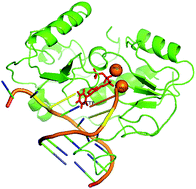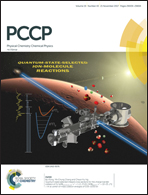Probing the communication of deoxythymidine triphosphate in HIV-1 reverse transcriptase by communication maps and interaction energy studies†
Abstract
We calculate communication maps for HIV-1 Reverse Transcriptase (RT) to elucidate energy transfer pathways between deoxythymidine triphosphate (dTTP) and other parts of the protein. This approach locates energy transport channels from the dTTP to remote regions of the protein via residues and water molecules. We examine the water dynamics near the catalytic site of HIV-1 RT by molecular dynamics (MD) simulations. We find that, within the catalytic site, the relaxation of water molecules is similar to that of the hydration water molecules present in other proteins and the relaxation time scale is fast enough to transport energy and helps in communication between dTTP and other residues in the system. To quantify energy transfer, we also calculate the interaction energies of dTTP, 2Mg2+, doxy-guanosine nucleotide (DG22) with their surrounding residues by using the B3LYP-D3 method. The results, from classical vibrational energy diffusivity and QM interaction energy, are complementary to identify the important residues involved in the process of polymerization. The positive and negative interactions by dTTP with different types of residues in the catalytic region make the residues transfer energy through vibrational communication.



 Please wait while we load your content...
Please wait while we load your content...